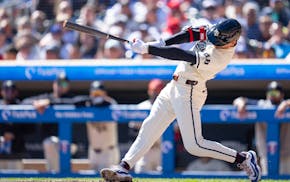Emily Castanias thought she was giving everything she had while running in the Victoria Lions Invitational cross-country meet in October. But the results didn't jibe with her effort, baffling the Chanhassen senior.
"I felt like I was running at a good race pace," she said. "But in reality, it was a good two, three minutes slower than what I was used to. I just couldn't get my legs to go faster.''
A natural at distance running since taking up the sport in seventh grade, Castanias never had dealt with anything more than typical soreness or occasional blisters. Her track and field times in the 1,600- and 3,200-meter runs had been good enough to land her a partial scholarship to the University of Minnesota.
But now, something was obviously wrong.
After discussions with her coaches, Castanias took a midseason break and consulted doctors. The diagnosis? Severe deficiencies in key nutrients vital to running.
"There was an iron deficiency on top of a lot of other random deficiencies," she said. "I was feeling fatigued all the time."
Her coach, Anita Woodrow, a former University of Minnesota runner herself, knew iron deficiencies were common in runners but had never seen a case this serious.
"Even the coloring of her skin was pale," Woodrow said. "She was barely keeping her eyes open."
As bad as she looked, Castanias felt worse. Not only could she not run as she used to, but her goals as a runner were fading away.
"It was such a shock," she said. "I was like, 'Is my running career over? Am I done?' "
Woodrow said many runners don't understand the need for proper nutrition.
"You burn so many calories running that, for girls especially, the whole 1,800-calorie -a-day diet is not for you," she said. "You need more like 3,000 calories a day."
After nearly three weeks of resting without running and overloading on iron-rich foods, Castanias returned for the cross-country section meet. Her improvement was drastic.
"I felt so good. It was like a whole different season," Castanias said.
She finished in the top five in the section meet, then ended up 35th in the Class 2A state meet. Not quite what she envisioned when the season began, but she considered her result a victory.
"I'm totally happy with it," she said. "I finished with my best time ever at the state meet."
Six months later, Castanias' recovery is complete. She still binges on iron-laden foods — "It's not that hard to whip up a spinach smoothie," she said — but her running never has been better.
So far this spring, she's posted one of the top times in the state in the 3,200 meters at 10 minutes, 34 seconds. She has the third-best time in Class 2A at 1,600 meters (5:03.51).
"My goal is to break five minutes and I'm on pace to do that," she gushed.
Perhaps most importantly, Castanias said she has developed a deeper appreciation of her gifts.
"It's gone from being so negative to so positive," Castanias said. "I went from being worried about my future with the Gophers to getting a scholarship. Instead of just being about times and what place I finished, I realize how much it means to me just to be able to run and be with the team."
Jim Paulsen • 612-673-7737

Live: Minnesota United at Charlotte FC. Follow on Gameview.
Jameson Taillon comes off the injured list and helps the Cubs beat the Marlins 8-3
T-wolves take NBA's best defense into series vs. Suns, but can it stop Durant-Booker-Beal trio?

